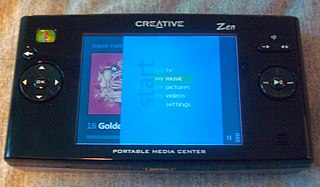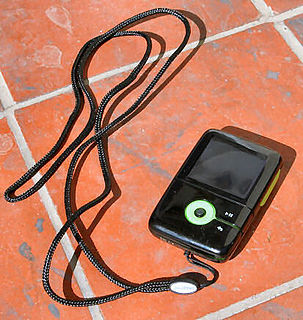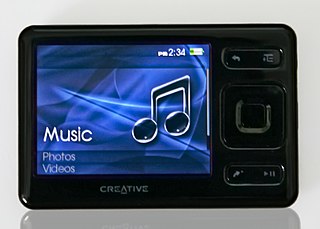Related Research Articles

Walkman, stylised as WALKMAN (ウォークマン), is a brand of portable audio players manufactured and marketed by Sony since 1979. The original Walkman was a portable cassette player and its popularity made "walkman" an unofficial term for personal stereos of any producer or brand. By 2010, when production stopped, Sony had built about 200 million cassette-based Walkmans. The Walkman brand was extended to serve most of Sony's portable audio devices, including DAT players, MiniDisc players/recorders, CD players, transistor radios, mobile phones, and digital audio/media players. As of 2022 the Walkman range consists exclusively of digital players.

The iPod is a series of portable media players and multi-purpose mobile devices designed and marketed by Apple Inc. The first version was released on October 23, 2001, about 8+1⁄2 months after the Macintosh version of iTunes was released. As of 2022, only the 7th-generation iPod Touch remains in production.
The NOMAD was a range of digital audio players designed and sold by Creative Technology Limited, and later discontinued in 2004. Subsequent players now fall exclusively under the MuVo and ZEN brands.

Portable Media Center (PMC) is a portable media player (PMP) platform developed by Microsoft. Announced at the 2003 Consumer Electronics Show (CES), and released in early 2004, it was originally positioned as a competitor to Apple's iPod. All its hard drive-based players use a graphical user interface (GUI) modeled after Media Center, a software portal bundled with Windows XP Media Center Edition. Manufacturers of PMC devices included Creative, Philips, iriver, Samsung, and Toshiba.

ZEN is a series of discontinued portable media players designed and manufactured by Creative Technology Limited. The players evolved from the NOMAD brand through the NOMAD Jukebox series of music players, with the first separate "ZEN" branded models released in 2004. The last Creative Zen player, X-Fi3, was released at the end of 2011.

The Dell Digital Jukebox or just Dell DJ is a brand name for a series of digital audio players sold by the Dell corporation.
Neuros Technology was a Chicago, Illinois–based company that produced a number of audio and video devices under the brand name Neuros. Founded by Joe Born in 2001 as a division of Digital Innovations, it previously operated under the name Neuros Audio. Like Digital Innovations, Neuros distinguished itself by its use of open-innovation and crowdsourcing techniques to bring products to market, as well as by its prominent use of open-source software and open-source hardware. In its development model, end users were involved throughout the product development process from reviewing initial concepts to beta testing initial product releases.

A portable media player (PMP) is a portable consumer electronics device capable of storing and playing digital media such as audio, images, and video files. The data is typically stored on a compact disc (CD), Digital Video Disc (DVD), Blu-ray Disc (BD), flash memory, microdrive, or hard drive; most earlier PMPs used physical media, but modern players mostly use flash memory. In contrast, analogue portable audio players play music from non-digital media that use analogue signal storage, such as cassette tapes or vinyl records.
Janus is the codename for a portable version of Windows Media DRM for portable devices, whose marketing name is Windows Media DRM for Portable Devices introduced by Microsoft in 2004 for use on portable media devices which store and access content offline. Napster To Go was the first online music store to require the Janus technology. Supporting Janus often implies that the device also make use of the Media Transfer Protocol (MTP).

Banshee is a cross-platform open-source media player, called Sonance until 2005. Built upon Mono and Gtk#, it used the GStreamer multimedia platform for encoding, and decoding various media formats, including Ogg Vorbis, MP3 and FLAC. Banshee can play and import audio CDs and supports many portable media players, including Apple's iPod, Android devices and Creative's ZEN players. Other features include Last.fm integration, album artwork fetching, smart playlists and podcast support. Banshee is released under the terms of the MIT License. Stable versions are available for many Linux distributions, as well as a beta preview for OS X and an alpha preview for Windows.

Zune is a discontinued line of digital media products and services marketed by Microsoft from November 2006 until its discontinuation in June 2012. Zune consisted of a line of portable media players, digital media player software for Windows PCs, a music subscription service known as a "Zune Music Pass", music and video streaming services for the Xbox 360 game console via the Zune Software, music, TV and movie sales, and desktop sync software for Windows Phone. Zune was also the provider of music streaming for United Airlines in-flight, after a partnership in 2010.
The following comparison of portable media players compares general and technical information for notable digital playback devices.

The ZEN Vision:M was a portable media player developed by Creative Technology, and was launched on December 8, 2005. The device's features and interface was adapted from the earlier released ZEN Vision with a smaller screen size and dimensions.
Zen is a school of Mahāyāna Buddhism notable for its emphasis on practice and experiential wisdom.

The ZEN V and the ZEN V Plus are portable media players manufactured by Creative Technology. The user interface on this player, the same as the one on Creative's ZEN Vision:M, was patented by Creative on January 9, 2005. Creative sued Apple over the use of this user interface; Apple later settled for $100 million.

The ZEN is a portable media player designed and manufactured by Creative Technology. This flash memory-based player is the de facto successor of the ZEN Vision:M and was announced on August 29, 2007, to be available in capacities of 2, 4, 8, and 16 GB, as of September 14. A 32 GB model was announced on December 4, 2007, setting a record for storage capacity among flash players.
Zvm may refer to:
The SigmaTel STMP3700 is a low power System on Chip made for PMP's. The STMP3700 is using a single ARM processor core clocked up to a maximum of 300 MHz The System on Chip was developed in 2007 for use in portable media players. It supports playing video in QVGA and decoding of various media formats. It is used in the Creative ZEN as of 2007, and the Creative ZEN X-Fi as of 2008. The STMP378x supports VGA resolutions of 640×480, higher clock frequencies and video hardware assist. Sony Walkman models using this product line include Salsa, Newton, and Freed which appeared at CES 2009. See Freescale's STMP3700 series site for more info.
Creative Technology Ltd. is a Singaporean multinational technology company headquartered in Jurong East, Singapore, with overseas offices in Shanghai, Tokyo, Dublin, and Silicon Valley. The principal activities of the company and its subsidiaries consist of the design, manufacture and distribution of digitized sound and video boards, computers and related multimedia and personal digital entertainment products. It also partners with mainboard manufacturers and laptop brands to embed its Sound Blaster technology on their products.

A dock connector is a connector used to attach a mobile electronic device simultaneously to multiple external resources. The dock connector will typically carry a variety of signals and power, through a single connector, to simplify the process of docking the mobile device. A dock connector may be embedded in a mechanical fixture used to support or align the mobile device or may be at the end of a cable.